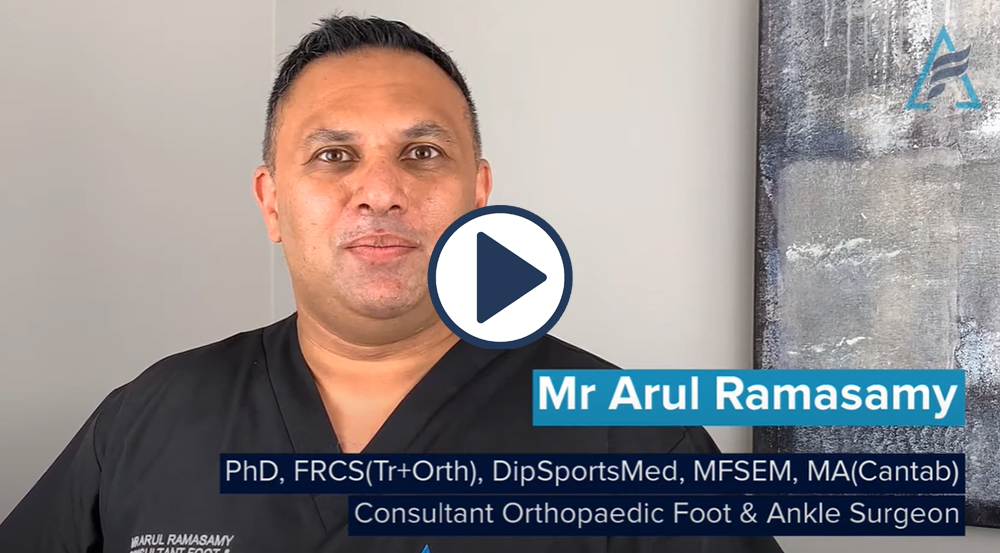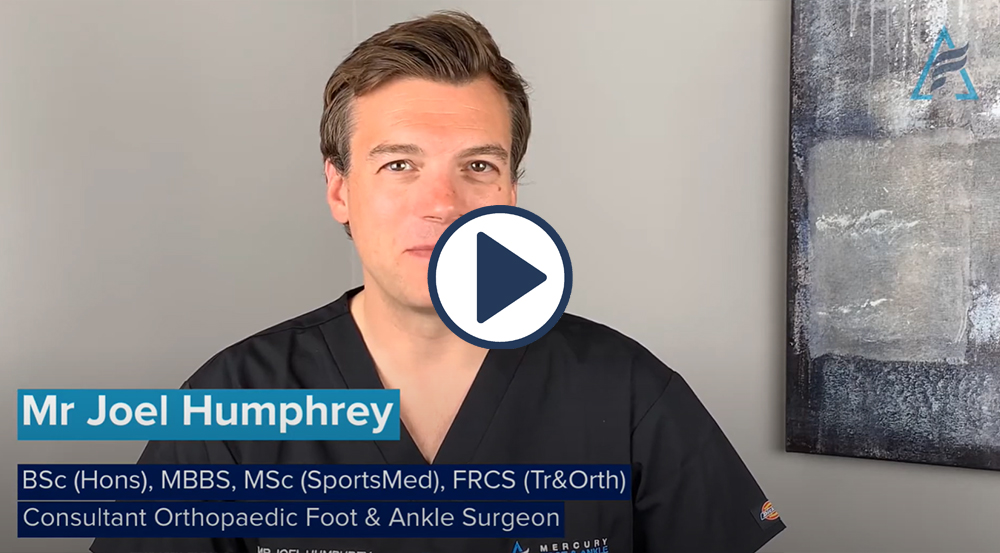Hindfoot Arthritis

What is hindfoot arthritis?
The hindfoot is the anatomical area at the back of the foot, composed of the talus and heel bones. Hindfoot arthritis develops when the hindfoot joints have damaged or worn out cartilage. It can affect one or more of the three hindfoot joints (subtalar, talonavicular and calcaneocuboid joints).
Hindfoot arthritis is characterised by pain, swelling and stiffness. Usually symptoms develop gradually overtime. The foot can subtly change shape with flattening of the medial arch and the heel bone points outwards.
Why does hindfoot arthritis develop?
Hindfoot arthritis develops for several reasons. The hindfoot is predisposed to developing post-traumatic arthritis following a fracture, for example a calcaneal fracture, even if initially well managed. Osteoarthritis of the hindfoot can develop even in the absence of an injury. The hindfoot can be affected in patients with inflammatory arthritis, for example rheumatoid or psoriatic arthritis. Posterior tibial tendon dysfunction is when the medical arch of the foot can flatten and overtime arthritis can develop.
What are the available treatments for hindfoot arthritis?
In the first instance simple treatment measures are recommended to try and reduce your symptoms. These can have significant benefit and help avoid having surgery. Some treatments for hindfoot arthritis are listed below, but it is not exhaustive.
Weight loss if you are overweight can be extremely effective to lessen further joint damage and reduce hindfoot pain.
Appropriate footwear should be tried consisting of a supportive shoe. Alternatively a “rocker bottom” shoe can reduce the forces going through the hindfoot joints whilst walking.
An Orthosis (a medical insole) can be useful in improving foot function and reducing pain. You can be referred to the Orthotist for a specialist opinion.
Simple painkillers such as paracetemol, ibuprofen or anti-inflammatory gels can reduce pain. Ask advice from your doctor or pharmacist before taking anti-inflammatory medicines as they can have side-effects in some people.
Physiotherapy may be beneficial in the early stages of the condition to keep the calf muscles stretched and avoid overloading the hindfoot whilst walking.
Steroid injection into the one or more of the hindfoot joints, although more invasive, can help reduce pain and inflammation.
Surgery for hindfoot arthritis is only recommended as a last resort, once all simple treatment measures have been exhausted and if your symptoms remain significant. Surgery most often entails a hindfoot fusion of one or more of the hindfoot joints.
Wellbeing Advice
Patients that have a healthy diet, take regular exercise and refrain from smoking are more likely to experience a quicker recovery with a more successful outcome from their surgery.
If you have any concerns about your general health and well-being (diet, exercise, smoking cessation) you are encouraged to discuss this with your GP, who will be able to provide advice on the options available to you.
We hope this leaflet has answered any questions you might have. If you have any further queries, please feel free to discuss them with any of the medical or nursing staff.
Testimonials

My condition had deteriorated to the point that I was unable to walk for extended periods of time without pain and swelling of the ankle, and I would rarely be able to join in most family activities. The support and guidance provided by Mr Ramasamy were exemplary and enabled me to make a fully informed decision regarding the options available to me. Now, the pain is much more manageable and the stability that the treatment has provided is such that I feel that I regained a significant part of my life and as such my confidence.
I found Mr Ramasamy extremely professional and reassuring. On the day of my procedure I received the most efficient, organised and professional care in my life. Your nurses were the best I have ever experienced. Mr Ramasamy’s team, in theatre made me feel at ease and made the whole procedure more bearable. They go way beyond the extra mile for their patients.
I wanted to share my excellent experiences and compliment Mr Ramasamy and his team. I found him extremely professional and reassured that he understood how much pain I was in. On the day of my procedure, it was the most efficient, organized and professional care I have ever received – from checking into reception to being allocated a bay and taken into theatre – your nurses in the recovery area were the best I have ever received. Mr Ramasay’s team, especially in theatre, made me feel at ease, kept me informed throughout the whole procedure and made the whole procedure more bearable.
Send Us A Message

If you have a question or want to reach out to us directly, use the contact form below and send us a message.








